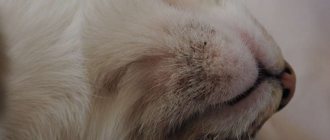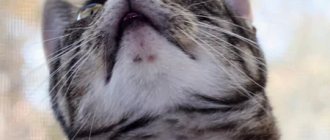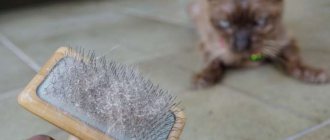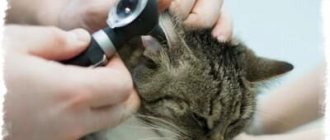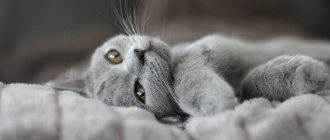27.08.2019
Skin diseases in cats
no comments
8266
Cat chin acne is a common skin condition in the feline species. To be more precise, this is the most common manifestation of acne in cats. It can appear at any age and the gender of the animal does not matter. The disease can get worse, worse, or even be extremely difficult to treat. Signs and symptoms range from barely noticeable comedones (blackheads) to severely inflamed and debilitating pustules. Some cats are not bothered at all, while for others, the pimples are very itchy and painful. Localized hair loss and skin redness are also common.
Symptoms of acne in cats on the chin
Many cats first develop a slightly dirty chin, covered in small black spots between the hair follicles. Sometimes, symptoms in cats are limited to just this manifestation. In other cases, it may begin to progress into swollen, red lumps that begin to rupture and bleed.
If the problem continues to progress, it is likely that the follicles may become infected with Staphylococcus aureus. This is a fairly common bacterial infection that can usually be found on the surface of the skin. This complication is called bacterial folliculitis. This serious skin infection requires more aggressive treatment. Folliculitis can also lead to secondary fungal infections if not treated properly.
Blackness and character
It is widely believed that black spots in a cat’s mouth are a sign of an aggressive, evil character. Especially when located on the palate or the inside of the lips. However, it has been proven that pigmentation does not affect the pet’s behavior in any way. With spots, he can be kind, affectionate, and flexible.
In 99% of cases, dark spots are not dangerous. They are normal pigmentation. If this is a concern, consult your veterinarian. Malignant tumors are rare, but are more often found in a severe stage and cannot be treated.
Causes of acne on the chin of cats
There are actually no known causes for cat acne on the chin. But some possible factors include:
- Stress
- Poor care
- Dermatitis
- Bacterial overload (eating from dirty bowls)
- Impaired production of sebum (fatty substance)
- Contact hypersensitivity
- Suppressed immune system
- Concomitant infection or disease
Plastic cat food bowls were once considered a possible cause of acne in cats (allergic or contact hypersensitivity). With new research, it is believed that the real problem is the level of bacteria found in plastic utensils. Switching to glass, metal or ceramic cookware can help get rid of acne in some cases. I recommend stainless steel. But it is equally important to wash bowls frequently, at least once a day. If you are using plastic, use this tip first. If this is the reason, then improvements begin to be tracked after a week or a week and a half.
In addition to the above, think about raising food and water bowls. You should try to do this in such a way that the cat’s chin does not come into contact with the contents of the bowls.
Just like humans, cats develop acne due to allergies. You should change your cat's food and treats to make sure they don't contain the ingredient that is causing the allergic reaction. You would likely notice other allergic symptoms and signs if your cat had a food allergy or allergic contact dermatitis, but not always.
Diagnosis of acne and pimples in cats
Diagnosis of acne, as well as the diagnosis of acne in cats, should be carried out exclusively by a veterinary dermatologist. Only such a veterinarian is able to exclude other variants of dangerous diseases and problems, such as ticks, fungal and bacterial infections (primary or secondary), or fleas. Among other things, you need to accurately assess the cat’s general health and how much acne bothers her and how much discomfort it causes her. Research and diagnostic techniques include: skin scraping for microscopy, as well as culture to identify fungal spores and bacteria.
In severe cases where the skin is red and tender, a biopsy may be performed. This is necessary because acne can mimic other more serious diseases that should be ruled out first. It could be ringworm, skin mites, or even fungal yeast infections. All of this should be ruled out before any treatment is started.
Here are more photos of symptoms and signs of acne and pimples on the chin of cats
Diagnosis and treatment
Although pigmentation in most cases is not dangerous, you should take your pet to the veterinarian. He will establish the exact cause using a visual examination, laboratory tests, and examination of the mucous membrane for bacterial contamination. Treatment:
- With acne, it is enough to get rid of the cause that caused the rash. The animal's condition will return to normal.
- Lentigo is a congenital manifestation, so no treatment is required.
- For fungal diseases, antiseptics are prescribed for rinsing (Stomadex, solutions of Chlorhexidine, hydrogen peroxide, furatsilin) and antifungal agents (potassium iodide, Clotrimazole, Amphotericin).
- Mycoplasmosis - therapy consists of restoring the immune system, giving antibiotics (Ofloxacin, Azithromycin), treating the oral cavity (Ribotan, Cycloferon). Probiotics and Feliferon injections can be prescribed.
- Oncological diseases often remain untreated.
For any reason, it is mandatory to include vitamin-mineral complexes in the diet.
More serious problems
Thus, a cat's tongue can be a real "barometer" of health. A change in color is an indicator that your cat may be sick. You can remember a simple truth: “A pink tongue is a healthy pet.” This rule is immutable; exceptions are very rare.
Why is that? The fact is that the tongue, as a muscular organ, is literally penetrated by many blood vessels, visible through the thin epithelial layer. If it is pink, everything is in order - the blood supply is normal, the red blood cells contain the required amount of hemoglobin. In many cases, a white tongue is a sign of poor oral hygiene, but below we will describe much more serious pathologies in which this organ also changes its color.
Preventive measures
Hygiene is very important when preventing acne
To ensure that blackheads no longer bother your pet, you need to adhere to the following recommendations:
- If after eating your cat constantly walks around with the remains of dried food on its face, the contaminated area should be wiped with wet wipes (they should be alcohol-free and fragrance-free);
- Choose only high-quality products and feed;
- Check your cat for fleas at least once a week (you need to examine the fur in the area of the hips, belly and withers);
- Do not give your pet strong medications without a doctor's prescription;
- If a cat often goes outside, you need to regularly wipe its paws and bathe it once a month;
- Once every three months, attention should be paid to the prevention of worms;
- Try to protect your pet from stress;
- Buy vitamins for your cat periodically;
- Do not delay going to the vet if you observe any alarming symptoms.
Have a purring day!
Fungal infections are one of the causes of blackness in the corners of a pet’s mouth.
Having noticed something black near the mouth of a cat, pet owners should be wary - such a sign may indicate the development of fungal diseases. It is not possible to determine the type of infection on your own; special studies will be required.
The danger of the disease is that if left untreated, the disease will progress rapidly. The lesion spreads through the mucous membranes and affects internal organs. Fungal spores can also penetrate the mucous membranes of the eyes and ear canals.
Rash prevention
To prevent black spots from appearing on the animal’s body, it needs to be provided with good living conditions and fed only from a glass, iron or ceramic bowl. In addition, it is imperative to clean the animal, give it vitamin complexes and ensure a balanced diet.
Cleaning your pet
It is necessary to carefully monitor the cleanliness of your pet's fur, especially on the chin. To prevent contamination, you should bathe your pet with special shampoos.
Balanced diet
A balanced diet will help speed up the healing process and prevent the development of the disease. In this case, it is best to give preference to specialized products that are suitable for a specific breed. Experts recommend feeding your pet not only dry food, but also including boiled fish, chicken, eggs, carrots and grass in the diet.
Note! It is strictly forbidden to feed your pet cheap food, as it contains a large amount of preservatives and flavorings.
Balanced nutrition for cats
Vitamin complexes
A loving owner must provide his pet with a sufficient amount of vitamins. They must be contained in food, so preference should be given to special balanced feed of good quality. In addition, the animal should be systematically given vitamin complexes that will ensure the health and well-being of the pet.
Black spots on a cat's chin may indicate a pathology that occurs when the sebaceous glands become inflamed. When abnormalities appear, the animal feels well at first, but symptoms of the disease appear after a long time. The domestic cat becomes like a yard cat and is unkempt. Why this happens and how to cope with the pathology can only be suggested by a specialist who will professionally determine the cause and prescribe qualified treatment.
Establishing diagnosis
You can collect anamnesis in advance to speed up diagnosis
To find out the cause of the formation of black spots, the veterinarian conducts studies such as taking an anamnesis, external examination, collecting material (scraping from the skin) and blood and tissue analysis. With the first point, you can greatly help the veterinarian if you collect information in advance about the past illnesses of the animal’s owners, nutrition, possible stress experienced in the coming days, as well as the pet’s lifestyle, and provide it to the doctor during the examination.
Infectious disease mycoplasmosis - symptoms, treatment
If your cat has blackness around his mouth, the cause may also be infectious lesions. One of the most common diseases is mycoplasmosis. The disease is characterized by a number of signs:
- mucous membranes change color and become darker;
- conjunctivitis develops before the eyes (the eyes turn sour);
- purulent fluid with an unpleasant odor is released from the mouth and nasal passages;
- the pet refuses to eat and behaves lethargically.
The infectious disease is especially dangerous for pregnant animals. There is a risk of miscarriage, and even timely treatment is not always effective in saving the offspring. The main reason for infection is a decrease in the body’s defenses against the background of serious diseases. Antibacterial drugs and drugs that enhance immunity are used for treatment.
Lentingo, what is it?
These skin defects have the intricate name “Lentigo”. Lentigo is an absolutely harmless skin defect, about a centimeter in size, in the form of a dark spot. Essentially, they are similar to our age spots. Most often, lentigo appears in cats of red or tortoiseshell color. Many veterinarians suggest that pigmentation is associated with the color of the animal's coat. As a rule, they appear in cats in the first years of life.
Lentigo can be seen on the lips, nose and ears. First, minor spots ranging in size from 1-10 mm appear. Gradually the number of spots will increase and increase in size. But over time they will decline. Lentigo does not cause discomfort, pain, itching in the animal, and does not peel off. However, we should not forget that a really dangerous disease can be mistaken for Lentigo. Therefore, you should not make diagnoses yourself. In any case, you need to contact a veterinarian, where a sample of skin tissue will be taken from your pet and sent to the laboratory for tests, where an accurate diagnosis will be established!
If you urgently need to get yourself an MRI and you are in the glorious city of Saratov, then you can find out the price of an MRI in Saratov by clicking on this link. The medical center is always ready to help, be it an MRI or treatment of a disease, but it’s better to be healthy, rich and happy! That’s what the “Red Cat” website wishes for you!
Watch the graceful trained cats perform! Such funny little pussies!
Thank you for your likes and comments, come again! Health to your furry pets!
Ginger cats and cats are amazing creatures - mysteries! They give their tenderness, kindness and joy to people!
Did you like the post on the Red Cat website? Click on the buttons below if you liked the article. Please press everything one by one, thank you!


